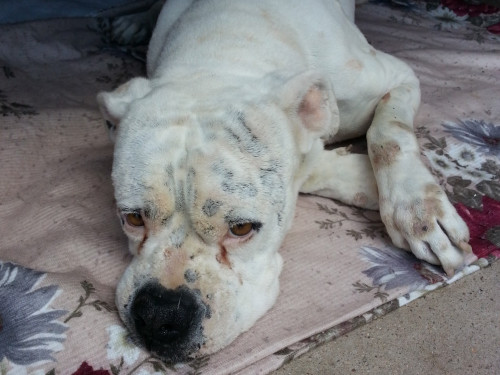Regular vaccinations can protect your pet from contracting often deadly diseases.
 Rabies is an acute viral infection that is usually caused by the bite or scratch of an infected animal that has rabies virus in its saliva. The virus travels along the nerves to the brain. It can take days, weeks, or months before clinical signs start to show. These could be sudden behavioral changes in temperament, aggression and signs of apprehension. Seizures and tremors that can lead to paralysis are also common.
Rabies is an acute viral infection that is usually caused by the bite or scratch of an infected animal that has rabies virus in its saliva. The virus travels along the nerves to the brain. It can take days, weeks, or months before clinical signs start to show. These could be sudden behavioral changes in temperament, aggression and signs of apprehension. Seizures and tremors that can lead to paralysis are also common.
If your cat has been bitten by or exposed to a wild or potentially rabid animal give us a call immediately and report it to local animal control authorities.
Unvaccinated cats that are exposed to a rabid animal may need to be euthanized or placed in strict isolation for six months.

Rabies Virus under a microscope
Neumeister Animal Hospital uses Purevax Feline Rabies Vaccine. It protects without the need for adjuvants, which are additives that may present potential risks such as injection site reactions and chronic inflammation. Purevacs is approved for use in kittens as young as 12 weeks old.

Feline Leukemia is one of the most significant causes of illness and death among cats. It contributes to infectious diseases, anemia, and cancer by suppressing the immune system and bone marrow production. It is primarily spread by persistently infected cats. There is no cure, but you can protect your cat with a simple vaccination.
All it takes to spread feline leukemia is contact with bodily fluids. This can happen from
Kittens can even contract the disease from their mothers while nursing or still in the womb.
We recommend Purevax Recombinant Vaccine because it protects without adjutants that present potential risks such as injection site reactions and chronic inflammation.
Feline distemper (panleukopenia) is a very contagious, dangerous disease that typically occurs suddenly. It will cause fever, loss of appetite, dehydration, vomiting, diarrhea, hypothermia, and, all too often, death. It can affect cats and kittens, though mortality is higher in young cats. Cats become infected when they ingest the feces of an infected cat.
Feline respiratory disease is a chronic upper respiratory infection in cats. It is spread from cat to cat by contaminated litter boxes and water bowls, or contact with infected fluids such as saliva, nasal secretions, and eye discharge.

 Rabies is an acute viral infection that can affect all warm-blooded animals. It is commonly caused by the bite of an infected animal that has rabies virus in its saliva. Younger animals are usually more susceptible to rabies infection, and it’s always fatal once clinical signs appear.
Rabies is an acute viral infection that can affect all warm-blooded animals. It is commonly caused by the bite of an infected animal that has rabies virus in its saliva. Younger animals are usually more susceptible to rabies infection, and it’s always fatal once clinical signs appear.
If your pet has been bitten by or exposed to a wild or potentially rabid animal, talk with your veterinarian right away and report it to local animal control authorities. Even if your pet has a current vaccination, you should still contact your veterinarian.
Once the rabies virus enters the body, it travels along the nerves to the brain. It can take a matter of days, weeks or months for your pet to show signs of the rabies virus.
Some of the signs are:
Dogs that have never been vaccinated and are exposed to a rabid animal may need to be euthanized or placed in strict isolation for six months.
 Lyme disease is a painful disease caused by bacteria and is transmitted by ticks. Some dogs might not display any clinical signs, while others will start limping, swelling in the lymph nodes, and fever which can progress to include loss of appetite and lethargy. It can also attack a dog’s joints and be very painful. These signs may not show up until two to six months after contracting the disease. Antibiotics can help treat the disease but do not eliminate the organism which can strike over again and again once it was contracted. Dogs can also bring infected ticks into the home or yard where the ticks may spread the disease to people. The “black-legged” or Deer tick and the Western Blacklegged tick are smaller than other species of ticks, which makes them more difficult to detect.
Lyme disease is a painful disease caused by bacteria and is transmitted by ticks. Some dogs might not display any clinical signs, while others will start limping, swelling in the lymph nodes, and fever which can progress to include loss of appetite and lethargy. It can also attack a dog’s joints and be very painful. These signs may not show up until two to six months after contracting the disease. Antibiotics can help treat the disease but do not eliminate the organism which can strike over again and again once it was contracted. Dogs can also bring infected ticks into the home or yard where the ticks may spread the disease to people. The “black-legged” or Deer tick and the Western Blacklegged tick are smaller than other species of ticks, which makes them more difficult to detect.
Protect your dog:
Protect yourself:
Avoid heavily wooded areas during the tick season, but if this is not possible wear light-colored clothing to help you see and remove ticks before they attach.
Wear long-sleeved shirts tucked into long pants tucked into socks. Conduct frequent, full-body tick checks.
More detailed information can be read on our “Tick and mosquito born diseases” page.

Photo to the left shows dog with Canine distemper Infected dog with nasal discharge and hyperkeratotic nose
Canine distemper is a virus that affects a dog’s respiratory, gastrointestinal, and central nervous systems, as well as the conjunctival membranes of the eye. The virus is passed from dog to dog through direct contact with fresh urine, blood, or saliva. Sneezing, coughing, and sharing food and water bowls are all possible ways for the virus to be passed on.
The first signs of canine distemper include:
Please call us immediately if you suspect your dog has been infected with the canine distemper virus. The virus spreads rapidly and must be aggressively treated as soon as it’s discovered.
To prevent your dog from getting infected you should make sure your dog has completed his series of vaccinations. The vaccine for dogs is called the distemper shot. If you have a puppy, make sure he gets his first vaccination at six to eight weeks of age. Be sure to keep him away from any possibly infectious dogs or environments until he’s finished with his vaccinations at four or five months old. Also, routine cleaning and disinfecting of your home (or kennel) will ensure that the virus is not in your dog’s living environment.
There is currently no available medication that can destroy the virus that causes canine distemper. Rather, supportive care is the mainstay of treatment. We can offer intravenous fluids to prevent dehydration and antibiotics to ward off secondary infections while the infected dog builds up his immune response. Some dogs are able to survive the infection, while for others canine distemper can be fatal.
Source: http://www.aspca.org/pet-care/dog-care/distemper
Canine parvovirus is a highly contagious viral disease that can produce a life-threatening illness. The virus attacks rapidly dividing cells in a dog’s body, most severely affecting the intestinal tract. Parvovirus also attacks the white blood cells, and when young animals are infected, the virus can damage the heart muscle and cause lifelong cardiac problems.
The general symptoms of parvovirus are:
Parvovirus is extremely contagious and can be transmitted by any person, animal, or object that comes in contact with an infected dog’s feces. Highly resistant, the virus can live in the environment for months and may survive on inanimate objects such as food bowls, shoes, clothes, carpets, and floors. It is common for an unvaccinated dog to contract parvovirus from the streets, especially in urban areas where there are many dogs. You can protect your dog from this potential killer by making sure he’s up-to-date on his vaccinations. Parvovirus should be considered a core vaccine for all puppies and adult dogs.
 Because parvovirus can live in an environment for months, you will want to take extra care if there has been an infected dog in your house or yard. Some things are easier to clean and disinfect than others—and even with excellent cleaning, parvovirus can be difficult to eradicate. Parvo is resistant to many typical disinfectants. A solution of one part bleach to 32 parts water can be used where organic material is not present. The infected dog’s toys, food dish, and water bowl should be properly cleaned and then disinfected with this solution for 10 minutes. If not disinfected, these articles should be discarded. You can also use the solution on the soles of your shoes if you think you’ve walked through an infected area. Areas that are harder to clean (grassy areas, carpeting, and wood, for example) may need to be sprayed with disinfectant or even resurfaced.
Because parvovirus can live in an environment for months, you will want to take extra care if there has been an infected dog in your house or yard. Some things are easier to clean and disinfect than others—and even with excellent cleaning, parvovirus can be difficult to eradicate. Parvo is resistant to many typical disinfectants. A solution of one part bleach to 32 parts water can be used where organic material is not present. The infected dog’s toys, food dish, and water bowl should be properly cleaned and then disinfected with this solution for 10 minutes. If not disinfected, these articles should be discarded. You can also use the solution on the soles of your shoes if you think you’ve walked through an infected area. Areas that are harder to clean (grassy areas, carpeting, and wood, for example) may need to be sprayed with disinfectant or even resurfaced.
Although there are no drugs available that can kill the virus yet, treatment is generally straightforward and consists of aggressive supportive care to control the symptoms and boost your dog’s immune system to help him win the battle against this dangerous disease. Dogs infected with parvovirus need intensive treatment in a veterinary hospital, where they receive antibiotics, drugs to control the vomiting, intravenous fluids, and other supportive therapies. Should your dog undergo this treatment, be prepared for considerable expense—the average hospital stay is about 5-7 days.
Please note that treatment is not always successful—so it’s especially important to make sure your dog is vaccinated.
source: http://www.aspca.org/pet-care/dog-care/parvovirus
Back to top ↑
 Your pet’s immune system is like an “army” that recognizes and fights off germs like viruses or bacteria that can make them sick. By administering the vaccine they receive a little piece of the specific germ or a weakened version of it. This is not enough to make them sick, but it’s enough to get their immune system’s attention. If they are exposed to the real germ in the future, their immune system will be able to recognize it and fight it off before it can make them sick.
Your pet’s immune system is like an “army” that recognizes and fights off germs like viruses or bacteria that can make them sick. By administering the vaccine they receive a little piece of the specific germ or a weakened version of it. This is not enough to make them sick, but it’s enough to get their immune system’s attention. If they are exposed to the real germ in the future, their immune system will be able to recognize it and fight it off before it can make them sick.